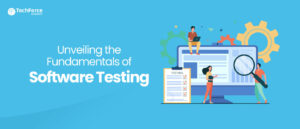In a world driven by innovation and efficiency, you might have felt the evolving landscape of programming to be daunting or time-consuming. The good news for you is that there’s a transformative shift happening – the future of programming is embracing low-code/no-code development. In this blog, we’ll dive into the benefits and challenges of low-code no-code (LCNC), offering insights that cater to both seasoned developers and those exploring this transformative approach for the first time.
What is low code and no code?
Low-Code
low-Code simplifies the coding experience with visual interfaces and drag-and-drop functionality. Even if you have little to no coding background, you can effortlessly build software applications. This innovative approach eliminates the necessity for intricate lines of code, making the development process not only more accessible but also remarkably efficient.
No-Code
No-Code takes simplicity to new heights by completely removing the need for coding. Through No-Code platforms, you have the ability to construct applications using only visual interfaces and pre-built components, transforming the process into something achievable for those without any coding background. This user-friendly approach opens up a world of possibilities, allowing you to bring your ideas to life without the constraints of traditional coding requirements.
Importance of low-code/no-code in the future of programming
The growing importance of low code and no code in the tech industry is undeniable. Businesses are increasingly embracing these methodologies to streamline development processes, a trend that is set to redefine the programming landscape.
According to Gartner – By 2025, 70% of new business applications will use low-code/no-code technologies. As low code and no code platforms continue to evolve and mature, they offer a solution for organisations looking to accelerate their digital transformation.
These methodologies empower business users and citizen developers to create applications without extensive coding knowledge, reducing reliance on traditional IT departments. This not only accelerates the speed of application creation but also reduces the heavy reliance on skilled programmers. Therefore, LCNC’s influence is not just a fleeting trend but rather a transformative force that will shape the future of programming.
Traditional programming vs. the low code/no code development
- Traditional programming requires a high level of coding proficiency in languages like Java, Python, or C#. However, the low-code and no-code significantly lowers the coding barrier, allowing you with minimal coding experience to create applications using visual interfaces and pre-built components.
- When it comes to development speed, traditional programming might involve lengthy timelines as you create code from scratch, while low code/no code accelerates development with drag-and-drop functionalities and pre-built elements, facilitating rapid application creation.
- Finally, the learning curve differs, with traditional programming having a steeper curve requiring extensive training, while low code no code provides a more accessible entry point, enabling individuals like you with diverse backgrounds to participate in application development without the need for extensive coding knowledge.
Examples of successful low-code/no-code platforms
OutSystems
OutSystems is a highly successful low-code platform, facilitating the rapid development and deployment of robust applications for organisations. Its user-friendly interface and minimal coding requirements empower teams to create efficient solutions without extensive programming skills.
Mendix
Mendix is a widely embraced no-code platform that empowers users to craft applications without prior programming knowledge. With its intuitive visual development environment and advanced tools, Mendix enables individuals to bring their app ideas to life seamlessly.
Appian
Appian distinguishes itself as a successful low-code platform offering a comprehensive set of features for building enterprise-grade applications. This platform empowers organisations to streamline business processes and expedite digital transformation efforts.
Microsoft PowerApps
Microsoft PowerApps is a widely utilised no-code platform, that provides a user-friendly environment for building custom applications and business solutions. Leveraging pre-built templates, drag-and-drop functionality, and seamless integration with various Microsoft services.
Airtable
Airtable emerges as a successful low-code platform, fusing the flexibility of spreadsheets with robust collaboration features. It enables users to visually organise, track, and manage projects and data efficiently.
Bubble
Bubble is a popular no-code platform, that empowers both individuals and businesses to create web and mobile applications visually. With its design-centric approach and a range of powerful features, Bubble provides a platform for customisation and seamless integration.
Zapier
Zapier shines as a successful no-code platform, offering users a simplified and efficient way to automate tasks and integrate various web applications seamlessly. By eliminating the need for coding, Zapier provides a user-friendly solution for connecting and automating favourite tools.
Salesforce Platform
Salesforce is a widely adopted low-code platform, that provides organisations with a suite of tools and services for building and extending Salesforce applications. This empowers businesses to customise and tailor their CRM experience.
ServiceNow App Engine
ServiceNow stands out as a successful low-code platform, offering a powerful, scalable, and secure environment for creating enterprise-level applications. It enables organisations to automate IT tasks and processes.
Quickbase
Quickbase is a popular no-code platform, that facilitates the rapid development of custom business applications. With pre-built templates and robust functionality for database management and reporting, Quickbase empowers users to create tailored solutions efficiently.
Benefits of using low-code/no-code programming
Understanding the low code no code benefits is essential for grasping how this innovative programming landscape is reshaping the way applications are developed and empowering individuals across various technical backgrounds to actively participate in the creation process.
1. Accessibility and democratisation of development
No-code low-code is a game-changer because it simplifies creating things, even if your tech knowledge is limited. Traditional programming languages can be tough, especially if you’re not a tech expert. But now, thanks to low-code and no-code platforms, you can easily make and customise apps using visual interfaces and pre-built components, even if you’re not big on coding.
This democratisation of the development process extends an empowering invitation to a wider spectrum of users, fostering not only innovation but also collaborative synergy across diverse teams.
2. Increased productivity and faster time-to-market
Low-code no-code platforms automate a big chunk of the coding work. This means you get to focus more on the crucial logic and functions of your application. As per the latest reports from Kissflow Organisations that use low-code platforms to build customer-facing apps increase revenue by 58% on average. It’s not just about speeding up development; it also reduces the risk of making mistakes or running into issues.
Because of this, you can bring your software solutions to the market quickly, giving your organisation an edge in the fast-paced digital landscape.
3. Cost-efficiency and resource optimisation
Traditional development processes require a large team of developers, testers, and other IT professionals, which can be costly to hire and maintain. But now, with low code no code development platforms, you don’t need as many developers because a lot of the coding is done automatically.
This not only saves money on paying a big team but also lets you use that money for other important parts of your business. Plus, these platforms often have pre-built templates and modules, so you don’t have to do as much coding and building from scratch.
4. Integration capabilities
Low-code/no-code platforms are designed to seamlessly connect with existing systems and applications, allowing for smooth data flow and collaboration across different platforms. You don’t have to spend a lot of time and effort doing complicated manual integrations because these platforms do it for you.
Furthermore, these platforms often offer a wide range of pre-built connectors and APIs, making it easier to integrate with popular third-party services and tools.
5. Scalability and flexibility
In your business journey, you can use these platforms to quickly change or add things, keeping up with what people want and the market needs. The best part? You have the freedom to customise these platforms easily, creating unique solutions that fit exactly what you need. This makes low code and no code platforms your go-to tool for getting creative and staying ahead in the fast-paced digital world we’re in.
Examples of successful implementations of low code no code in various industries
No code and low code platforms are used in various industries to streamline processes, improve customer experiences, and streamline operations. For example, financial institutions use low-code platforms to streamline onboarding, enhance mobile banking applications, and automate workflows. Healthcare uses low-code solutions for patient management and health monitoring tools.
Manufacturing uses low-code platforms for inventory management and quality control. Retailers create customised e-commerce platforms, while educational institutions use them for student information systems and learning management. Governments use low-code applications for citizen service portals and document management.
The future of programming and the integration of low-code/no-code tools
As LCNC platforms continue to gain popularity, traditional programmers are not being pushed aside; instead, they’re discovering fresh avenues for collaboration with citizen developers who embrace these tools. This partnership enables programmers to delve into intricate and specialised tasks, while citizen developers swiftly bring their ideas to life using low-code/no-code tools. This change doesn’t just make things more efficient; it cultivates a culture of innovation, breathing new life into organisations.
Will low-code no-code replace developers?
The rise of low-code and no-code technologies has sparked debates about their potential to replace traditional developers. However, it’s important to view these tools as valuable additions to a developer’s toolkit; they simplify routine tasks and expedite the development process. Yet, when it comes to intricate and specialised projects, the expertise of skilled developers remains indispensable.
These technologies create collaboration opportunities, allowing developers to focus on design and architecture. The future of low-code no-code tools is expected to be a symbiotic relationship, enhancing accessibility in the evolving field of application development.
Emerging Technologies in Low-Code/No-Code
Artificial intelligence (AI) integration and blockchain applications are two key factors shaping the future of low-code/no-code development methodologies. Picture this: developers and citizen developers joining forces with AI by incorporating machine learning and natural language processing into low-code/no-code platforms.
This dynamic duo automates and streamlines various aspects of software development, ushering in a new era of efficiency. While, the integration of blockchain technology brings added security, transparency, and immutability to low-code/no-code development.
Conclusion
In conclusion, the low-code no-code movement is not just a passing trend but a fundamental shift in the way we approach software development and a transformative force shaping the future of development. It’s an invitation for all, regardless of technical expertise, to be part of a creative and innovative journey.
The journey has just begun, and the possibilities are limitless as we navigate the exciting terrain of a more accessible and efficient programming era.











